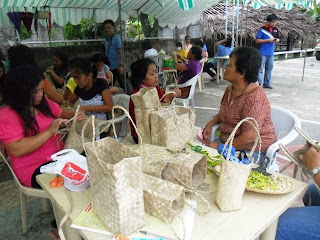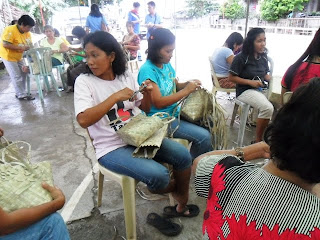
A skills training program in basket-weaving conducted a few months ago by the Marinduque office of the Department of Trade and Industry (DTI) in Mogpog drew the interest of residents of Brgy. Argao in the same municipality. A request was made by Argao residents through the barangay council of this coastal village in northern Mogpog for the holding of a separate training program for Argao residents.


Argao is located at the foot of Mataas na Bundok, the spot where Datum Station Balanacan lies, known as the geodetic center of the Philippines. Buri palm thrives in this area, locally known as buli. Buri palm has large fan-shaped leaves with stout petioles and has been used traditionally as material woven into banig, mats. The number of those skilled in bayong weaving has, however, waned over time.
The DTI skills training in bayong weaving with buri was thus undertaken in cooperation with the office of Cong. Allan Velasco and the barangay council. The three-day training project made use of this palm for fashioning into bayong, traditional bags or handbags as an alternative to the use of plastic bags. It also incorporated modern design trends and accessories to turn the palm leaves into fashionable handbags.



A few trainors sourced from the other barangays of Mogpog were tapped to teach the residents. The program includes a marketing scheme so that their produce could already be sold while in the process of improving product quality. A follow-up program for buri products bleaching and dyeing has, likewise, been scheduled.


Bottom pic shows DTI officials and staff with Cong Velasco's Chief of Staff and Brgy. Captain Sudil. From left, Celeste Miciano, Mariden Calub, DTI provincial director Carlito Fabalena, Brgy. Capt. Bonifacio Sudil, COS Erick Abad and Harry Gutierrez.
Buri palm (scientific name Corypha Elata).

